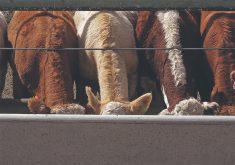Pork consumption in Canada dropped sharply in 2024 as price inflation reduced its appeal as a budget-friendly protein, Farm Credit Canada said in a recent report.
Consumption dropped roughly 12 per cent, year over year, said FCC senior economist Justin Shepherd in a Feb. 26 article.
Demand vs. consumption
The data gives some insight into consumers’ buying decisions, Shepherd explained.
“Demand” and “consumption” are often used interchangeably, but they have different meanings in economics. “Demand” refers to what consumers want to buy, whereas “consumption” is what they actually buy.
Read Also

CFIA adds controls for imports of Spanish feed ingredients after African swine fever outbreak
The Canadian Food Inspection Agency (CFIA) has added Spain to a list of countries subject to feed import controls due to an outbreak of African swine fever in that country.
“Pork demand has consistently been lower than consumption, indicating that consumers are buying it most likely as a cheaper alternative to beef and chicken and not necessarily because of a strong preference for pork,” Shepherd wrote.
While consumption and demand fell in the first half of the year, downward momentum increased in the third quarter as pork price inflation outpaced that of chicken. Pork consumption dropped seven per cent from Q2 to Q3.
Pork had considerable heights from which to fall. In 2023, consumption jumped by more than 14 per cent to nearly 23 kilograms per capita on an eviscerated basis, reported analyst Kevin Grier in June 2024. Beef consumption fell seven per cent while chicken consumption stayed level.
That year, retail pork prices increased by one per cent while consumer beef prices rose nearly eight per cent and chicken prices rose nine per cent, Grier said.
Global consumption growing
Shepherd said the decline in domestic pork consumption is a challenge for an industry working to recover from years of low revenues—particularly since the U.S. is expected to impose tariffs on Canadian goods.
Canada may be able to expand into markets like Mexico and South Korea, he said. Chinese consumption has plateaued and its domestic hog industry has nearly achieved self-sufficiency. However, Mexican consumption has increased 33 per cent since 2018 while South Korea is consuming 13 per cent more pork. Globally, consumption increased by two per cent in the same period.
“Both countries’ growth in consumption is being driven partially by higher production domestically but also higher imports, including from Canada,” Shepherd said.
“Exporters would do well to diversify globally and capitalize on strong world demand for pork, as they seek to offset the damage caused by American trade barriers.”
















